-

人教版新目标初中英语九年级下册You’re supposed to shake hands教案
教学目标:1. 掌握本单元一些重点词汇的写法和用法。2. 学会自如谈论餐桌礼仪。Step 1 RevisionAsk some students to retell the customs at the table in France in the passage in 3a.Step 2 Self checkPart 1. Fill in each bland with the correct word given. Students do the exercises by themselves at first. Then check the answers. Ask the students to comprehend the sentences and help them point out uses of some words, like “arrive (at / in) sw., spend time / money on sth , spend time / money (in) doing sth.”Part 2. Read about Fan Ling’s experience in a western restaurant. Understand the passage. Point out some key points in the passage.1. be / get used to doing sth. 习惯做某事2. begin with = start with 以….开头3. crowd v. 挤满,塞满 the crowd 人群 crowded adj. 拥挤的Then students discuss about how she would solve her problem. Ask some to share their stories with others.Part 3. Complete the crossword by looking at the sentences on the left. Then check the answers.

人教版新目标初中英语九年级下册Rainy days make me sad教案
1. 教材分析本单元以how do things affect you?为话题, 从颜色、天气、音乐、广告、产品等方面谈论了外界事物如何影响人的心情。要求学生掌握表达某物或某事给人带来的感觉、看法或影响等。共设计了四个部分的内容:Section A 该部分有4个模块:第一模块围绕Which restaurant would you like to go to?这一话题展开思维(1a)、听力(1b)、口语(1c)训练;第二模块围绕How does music affect you? 进行听力(2a-2b)、口语训练(2c);第三模块继续围绕how do colors in the restaurant affect you这一话题展开训练,训练形式为阅读和问题体验(3a)和小组活动(3b);第四模块仍就How do things affect you这一话题以调查的形式展开讨论。Section B该部分有4个模块:第一模块围绕产品广告对人们的影响这一话题以“配对”(1a)与“列举”(1b)两种形式展开训练;第二模块继续围绕How do things affect you? 进行听力(2a-2b)、口语对话训练(2c);第三模块围绕“Advertising”这一话题展开阅读(3a-3b)和写作(3c)训练;第四模块围绕How posters affect you这一话题以口语训练形式展开小组活动。
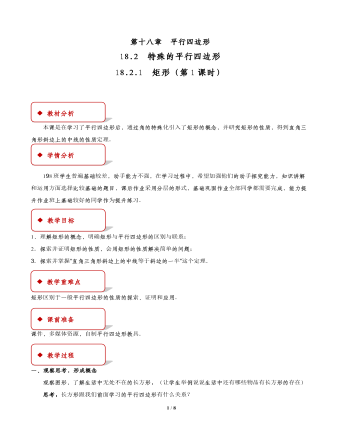
矩形第1课时教案
1. 理解矩形的概念,明确矩形与平行四边形的区别与联系;2.探索并证明矩形的性质,会用矩形的性质解决简单的问题;3.探索并掌握“直角三角形斜边上的中线等于斜边的一半”这个定理.

《安全》主题班会教案(1)
教育内容:一、学生安全管理制度1、在学校内不得打闹或搞恶作剧,课间活动要有秩序。2、在体育、自然实验课和课外活动时,要按老师要求正确进行或操作。3、不要把刀、匕首等危险物品带到学校。4、不经老师允许不准擅自离开教室或离开校园,到校后不准出校园。5、在校期间不要玩火、触摸电暖器等用电设备,不要带校外人员到校滋事。6、不准进网吧、游戏厅、舞厅、歌厅、台球社。7、按规定时间到校、离校,不要跟陌生人走,放学以后不要在学校逗留。8、不准把小食品带进学校,要吃卫生合格的食物,不要到卫生差、条件糟的小饭桌、小摊点就餐9、因事不能到校上课,要及时和班主任老师请假,并告之原因及去向。10、遵守交通安全法规,增强自我保护意识,牢固树立"安全第一"思想,健康成长。
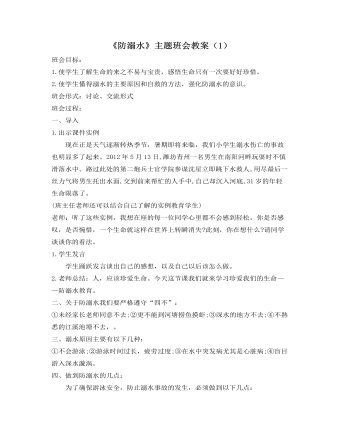
《防溺水》主题班会教案(1)
班会目标: 1.使学生了解生命的来之不易与宝贵,感悟生命只有一次要好好珍惜。 2.使学生懂得溺水的主要原因和自救的方法,强化防溺水的意识。 班会形式:讨论、交流形式 班会过程: 一、导入 1.出示课件实例 现在正是天气逐渐转热季节,暑期即将来临,我们小学生溺水伤亡的事故也明显多了起来。2012年5月13日,潍坊青州一名男生在南阳河畔玩耍时不慎滑落水中。路过此处的第二炮兵士官学院参谋沈星立即跳下水救人,用尽最后一丝力气将男生托出水面,交到前来帮忙的人手中,自己却沉入河底,31岁的年轻生命陨落了。 (班主任老师还可以结合自己了解的实例教育学生) 老师:听了这些实例,我想在座的每一位同学心里都不会感到轻松。你是否感叹,是否惋惜,一个生命就这样在世界上转瞬消失?此刻,你在想什么?请同学谈谈你的看法。
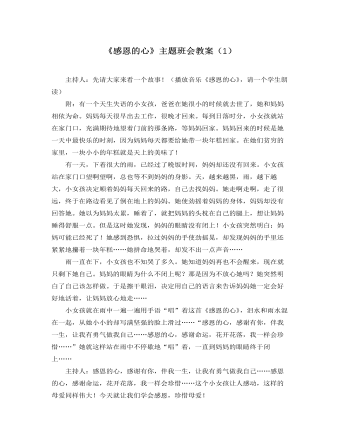
《感恩的心》主题班会教案(1)
主持人:然而我们又是怎样对待我们的父母的呢?下面我们来做个调查?你是否了解你的妈妈?1、你妈妈的生日是_________。2、你妈妈的体重是_________。3、你妈妈的身高是________。4、你妈妈穿_______码鞋。5、你妈妈喜欢颜色是________。6、你妈妈喜欢水果是________。7、你妈妈喜欢的花是________。8、你妈妈喜欢的日常消遣活动是_____________。请你如实回答。把你的答案写在一张纸寄给你妈妈评分答对6题以下的请你以后多与妈妈沟通。主持人:其实值得感恩的不仅仅我们的母亲,我们对父亲、师长、亲朋、同学、社会等等都应始终抱有感恩之心。我们的生命、健康、财富以及我们每天享受着的空气阳光水源,都应该在我们的感恩之列。一位盲人曾经请人在自己的乞讨用的牌子上这样写道:“春天来了,而我却看不到她。”我们与这位盲人相比,进一步说与那些失去生命和自由的人相比,目前能这样快快乐乐地活在世界上,谁说不是一种命运的恩赐,我们还会时常愤怒得发抖而总去抱怨命运给自己的不幸和不平吗?
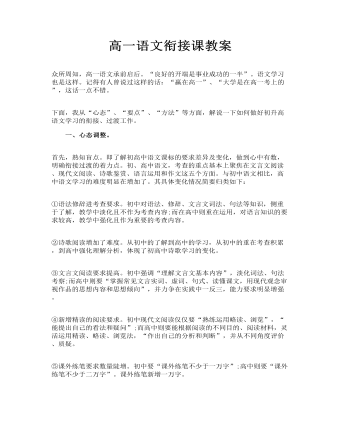
高一语文衔接课教案
一、心态调整。 首先,熟知盲点。即了解初高中语文课标的要求差异及变化,做到心中有数,明确衔接过渡的着力点。初、高中语文,考查的重点基本上聚焦在文言文阅读、现代文阅读、诗歌鉴赏、语言运用和作文这五个方面。与初中语文相比,高中语文学习的难度明显在增加了。其具体变化情况简要归类如下: ①语法修辞进考查要求。初中对语法、修辞、文言文词法、句法等知识,侧重于了解,教学中淡化且不作为考查内容;而在高中则重在运用,对语言知识的要求较高,教学中强化且作为重要的考查内容。 ②诗歌阅读增加了难度。从初中的了解到高中的学习,从初中的重在考查积累,到高中强化理解分析,体现了初高中诗歌学习的变化。

大班体育:高跷课件教案
2、 培养幼儿意志。二、活动重点难点: 幼儿在活动中的平衡能力。三、材料与环境创设 户外草地、高跷

初中法制安全教育教案
一.生活中有哪些意外 1.生活当中有哪些意外情况,或者在哪些方面,我们要注意安全?A(个别+补充回答) 比如有:火灾、用电安全、煤气中毒、交通事故、突发病症,遇见被偷被抢等等。 2.遇见这些紧急情况我们能不能慌张?A应该怎样才对?B为什么?C 不要慌张,在情绪上要镇定,因为越是慌张,对事情的处理其实越不利。
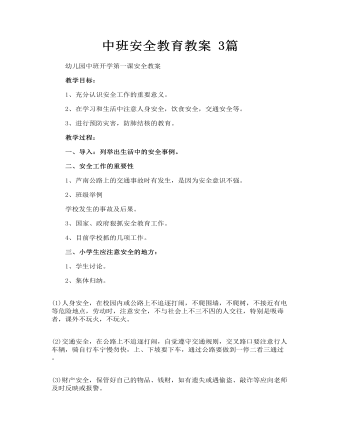
中班安全教育教案 3篇
二、安全工作的重要性 1、芦南公路上的交通事故时有发生,是因为安全意识不强。 2、班级举例 学校发生的事故及后果。 3、国家、政府狠抓安全教育工作。 4、目前学校抓的几项工作。
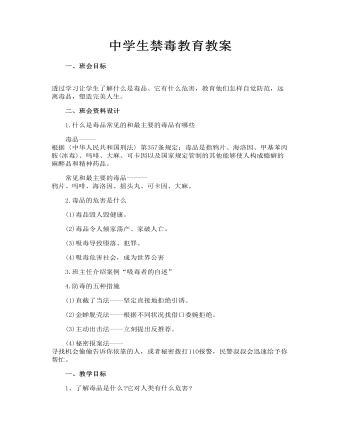
中学生禁毒教育教案
二、班会资料设计 1.什么是毒品常见的和最主要的毒品有哪些 毒品-----根据〈中华人民共和国刑法〉第357条规定:毒品是指鸦片、海洛因、甲基苯丙胺(冰毒)、吗啡、大麻、可卡因以及国家规定管制的其他能够使人构成瘾癖的麻醉品和精神药品。 常见和最主要的毒品------鸦片、吗啡、海洛因、摇头丸、可卡因、大麻。

中班体育教学活动教案
二、 活动目标:1、发展幼儿的投掷能力。 2、培养幼儿机智、勇敢,遵守纪律的品质。三、 活动重点与难点:有控制地用力向前掷物。四、 活动准备:1、听过解放军叔叔打仗的故事。2、娃哈哈瓶子为手榴弹,大筐子背面有图纸绘制的“石头”为碉堡,大纸箱做坦克车。红、蓝皱纹纸领结若干,投掷用的靶子。
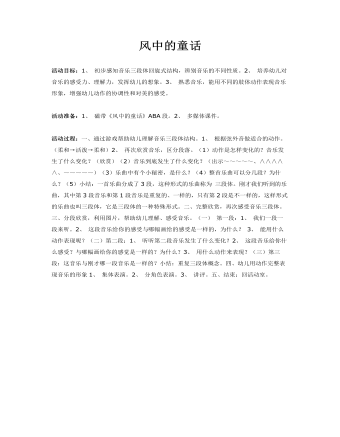
中班音乐教案:风中的童话
活动准备:1、磁带《风中的童话》ABA段。2、多媒体课件。活动过程:一、通过游戏帮助幼儿理解音乐三段体结构。1、根据弦外音做适合的动作。(柔和→活泼→柔和)2、再次欣赏音乐,区分段落。(1)动作是怎样变化的?音乐发生了什么变化?(欣赏)(2)音乐到底发生了什么变化?(出示~~~~~、∧∧∧∧∧、~~~~~)(3)乐曲中有个小秘密,是什么?(4)整首乐曲可以分几段?为什么?(5)小结:一首乐曲分成了3段,这种形式的乐曲称为三段体。刚才我们听到的乐曲,其中第3段音乐和第1段音乐是重复的、一样的,只有第2段是不一样的,这样形式的乐曲也叫三段体,它是三段体的一种特殊形式。二、完整欣赏,再次感受音乐三段体。三、分段欣赏,利用图片,帮助幼儿理解、感受音乐。(一)第一段:1、我们一段一段来听。2、这段音乐给你的感受与哪幅画给的感受是一样的,为什么? 3、能用什么动作表现呢?
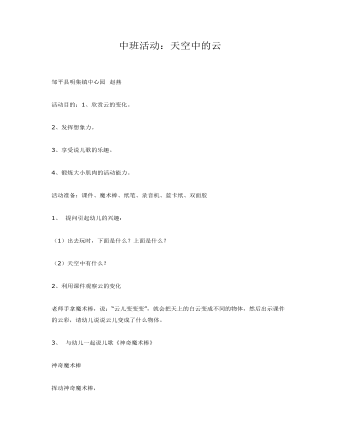
中班活动教案天空中的云
1、欣赏云的变化。2、发挥想象力。3、享受说儿歌的乐趣。4、锻炼大小肌肉的活动能力。活动准备:课件、魔术棒、纸笔、录音机、蓝卡纸、双面胶1、 提问引起幼儿的兴趣:(1)出去玩时,下面是什么?上面是什么?(2)天空中有什么?
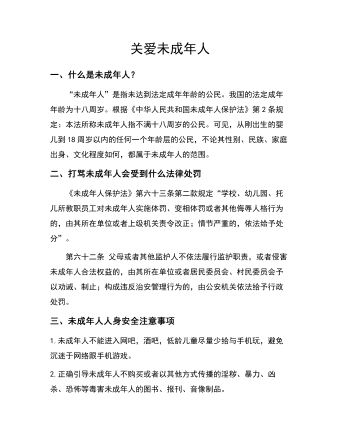
关爱未成年人教案
二、打骂未成年人会受到什么法律处罚《未成年人保护法》第六十三条第二款规定“学校、幼儿园、托儿所教职员工对未成年人实施体罚、变相体罚或者其他侮辱人格行为的,由其所在单位或者上级机关责令改正;情节严重的,依法给予处分”。第六十二条 父母或者其他监护人不依法履行监护职责,或者侵害未成年人合法权益的,由其所在单位或者居民委员会、村民委员会予以劝诫、制止;构成违反治安管理行为的,由公安机关依法给予行政处罚。

小班社会人际交往教案
1、小客人导入活动,激发幼儿活动的兴趣。 师:今天我们请来了许多小客人,可是它们很害羞,我们先向它们打个招呼吧。(教师出示动物、娃娃等毛绒玩具) ①请幼儿分组或自由向小客人打招呼。 ②引导幼儿说一说自己是如何向小客人们打招呼的。 2、学说短句:嘿嘿,我们是朋友 师:刚才小朋友都用不同的方式和小客人们打了招呼,老师也和它们打声招呼吧。“嘿嘿,我们是朋友。”
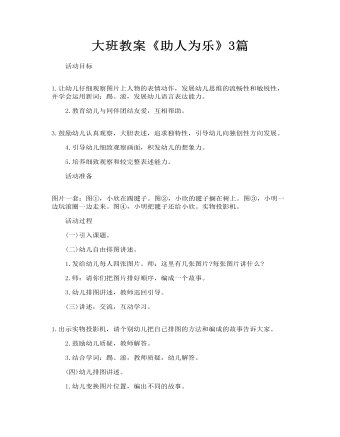
大班教案《助人为乐》3篇
(一)引入课题。 (二)幼儿自由排图讲述。 1.发给幼儿每人四张图片。师:这里有几张图片?每张图片讲什么? 2.师:请你们把图片排好顺序,编成一个故事。 3.幼儿排图讲述,教师巡回引导。
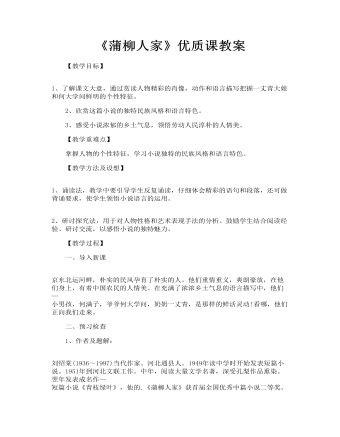
《蒲柳人家》优质课教案
一、导入新课 京东北运河畔,朴实的民风孕育了朴实的人。他们重情重义,爽朗豪放,在他们身上,有着中国农民的人情美。在充满了浓浓乡土气息的语言描写中,他们—小男孩,何满子,爷爷何大学问,奶奶一丈青,是那样的鲜活灵动!看哪,他们正向我们走来。 二、预习检查 1、作者及题解: 刘绍棠(1936~1997)当代作家。河北通县人。1949年读中学时开始发表短篇小说。1951年到河北文联工作。中年,阅读大量文学名著,深受孔梨作品熏染。翌年发表成名作—短篇小说《青枝绿叶》,他的.《蒲柳人家》获首届全国优秀中篇小说二等奖。
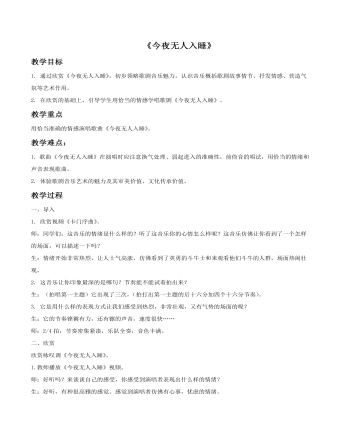
《今夜无人入睡》教案
教学过程一、导入1. 欣赏视频《卡门序曲》。师:同学们,这音乐的情绪是什么样的?听了这音乐你的心情怎么样呢?这音乐仿佛让你看到了一个怎样的场面,可以描述一下吗?生:情绪开始非常热烈,让人士气高涨,仿佛看到了英勇的斗牛士和来观看他们斗牛的人群,场面热闹壮观。2. 这音乐让你印象最深的是哪句?节奏能不能试着拍出来?生:(拍唱第一主题)它出现了三次,(拍打出第一主题的后十六分加四个十六分节奏)。3. 它是用什么样的表现方式让我们感受到热烈,非常壮观,又有气势的场面的呢?生:它的节奏铿锵有力,还有镲的声音,速度很快……师:2/4拍,节奏密集紧凑,乐队全奏,音色丰满。二、欣赏欣赏咏叹调《今夜无人入睡》。1.教师播放《今夜无人入睡》视频。师:好听吗?来谈谈自己的感受,你感受到演唱者表现出什么样的情绪?生:好听,有种很高雅的感觉。感觉到演唱者仿佛有心事,忧虑的情绪。师:这段歌剧咏叹调是王子卡拉夫猜出公主的谜语之后,在等待自己命运最后判决的前一夜,从忐忑不安到坚信爱情的复杂的心理变化过程。知道这位歌唱家是谁吗?他用的是什么演唱方法?这种唱法有什么特点?生:是帕瓦罗蒂,用的是美声唱法,声音立体,好像能传很远很远。师:为什么歌剧要选用美声唱法来演唱呢?难道它对情感的表达有什么关系?接下来我们一起体验一下这种演唱方法,并一起来探究:美声唱法对情感的表达的关系。2.教师范唱《今夜无人入睡》一两句。
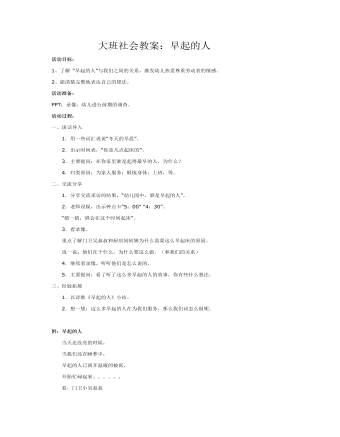
大班社会教案:早起的人
活动准备:PPT;录像;幼儿进行前期的调查。活动过程:一、谈话导入1.用一些词汇说说“冬天的早晨”。2.出示时间表,“你是几点起床的”。3.主要提问:在你家里谁是起得最早的人,为什么?4.归类原因:为家人服务;锻炼身体;上班,等。二、交流分享1.分享交流采访的结果,“幼儿园中,谁是早起的人”。2.老师设疑,出示钟点卡“5:00” “4:30”。“猜一猜,谁会在这个时间起床”。

